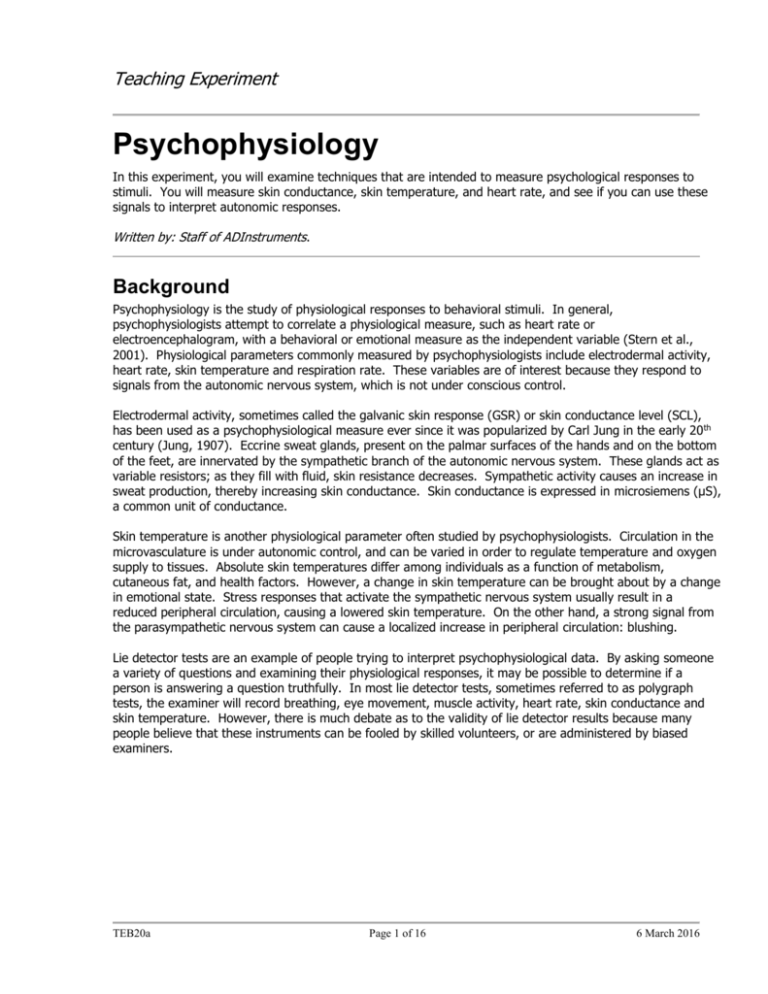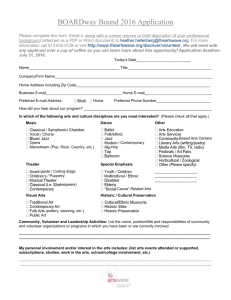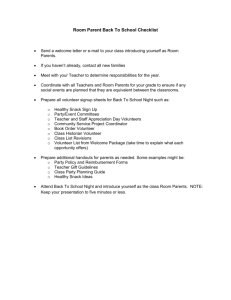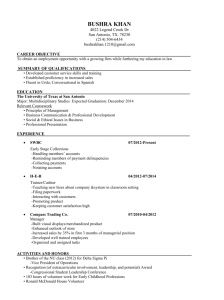
Teaching Experiment
Psychophysiology
In this experiment, you will examine techniques that are intended to measure psychological responses to
stimuli. You will measure skin conductance, skin temperature, and heart rate, and see if you can use these
signals to interpret autonomic responses.
Written by: Staff of ADInstruments.
Background
Psychophysiology is the study of physiological responses to behavioral stimuli. In general,
psychophysiologists attempt to correlate a physiological measure, such as heart rate or
electroencephalogram, with a behavioral or emotional measure as the independent variable (Stern et al.,
2001). Physiological parameters commonly measured by psychophysiologists include electrodermal activity,
heart rate, skin temperature and respiration rate. These variables are of interest because they respond to
signals from the autonomic nervous system, which is not under conscious control.
Electrodermal activity, sometimes called the galvanic skin response (GSR) or skin conductance level (SCL),
has been used as a psychophysiological measure ever since it was popularized by Carl Jung in the early 20 th
century (Jung, 1907). Eccrine sweat glands, present on the palmar surfaces of the hands and on the bottom
of the feet, are innervated by the sympathetic branch of the autonomic nervous system. These glands act as
variable resistors; as they fill with fluid, skin resistance decreases. Sympathetic activity causes an increase in
sweat production, thereby increasing skin conductance. Skin conductance is expressed in microsiemens (µS),
a common unit of conductance.
Skin temperature is another physiological parameter often studied by psychophysiologists. Circulation in the
microvasculature is under autonomic control, and can be varied in order to regulate temperature and oxygen
supply to tissues. Absolute skin temperatures differ among individuals as a function of metabolism,
cutaneous fat, and health factors. However, a change in skin temperature can be brought about by a change
in emotional state. Stress responses that activate the sympathetic nervous system usually result in a
reduced peripheral circulation, causing a lowered skin temperature. On the other hand, a strong signal from
the parasympathetic nervous system can cause a localized increase in peripheral circulation: blushing.
Lie detector tests are an example of people trying to interpret psychophysiological data. By asking someone
a variety of questions and examining their physiological responses, it may be possible to determine if a
person is answering a question truthfully. In most lie detector tests, sometimes referred to as polygraph
tests, the examiner will record breathing, eye movement, muscle activity, heart rate, skin conductance and
skin temperature. However, there is much debate as to the validity of lie detector results because many
people believe that these instruments can be fooled by skilled volunteers, or are administered by biased
examiners.
TEB20a
Page 1 of 16
6 March 2016
Teaching Experiment
Required Equipment
A computer system
Chart 5.0 or higher
PowerLab 4/25T
GSR Amplifier
GSR electrodes
Thermistor Pod
Skin temperature thermistor probe
Bio Amp patient cable
Three shielded snap-on lead wires
Disposable pre-gelled ECG electrodes
Abrasive pads/gel
Deck of playing cards
Medical tape
Procedures
A. Set up and calibration of equipment
1. Make sure the PowerLab is turned off and the USB cable is connected to your computer.
2. Connect the GSR Amplifier to the PowerLab by first attaching the I 2C cable from the “I2C Bus” on the
back panel of the PowerLab to the “Input” socket on the back of the GSR Amplifier (Figure 1). Then
connect the BNC to BNC cable from the “Signal Output” port on the back of the GSR Amplifier to the BNC
socket of Input 1 on the front panel of the PowerLab.
3. Connect the red and black GSR finger electrodes to the front of the GSR Amplifier (Figure 2). Do not
attach the electrodes to the volunteer.
4. Turn on the PowerLab. Note: The GSR Amplifier must be connected to the PowerLab before you turn on
the PowerLab.
5. Launch Chart 5 and open the settings file called “Startle Settings”. After a few seconds, a blank data file
will appear.
Figure 1. The rear panel of the GSR Amplifier, showing
connections for the I2C cable and BNC cable.
TEB20a
Page 2 of 16
6 March 2016
Teaching Experiment
Figure 2. PowerLab and GSR Amplifier set up for Exercise B.
Exercise 1: Skin conductance and the startle response
In this exercise, you will examine changes in skin conductance associated with the startle response.
If possible, conduct this exercise in a quiet room, away from distractions.
Zeroing the GSR Amp
The GSR Amplifier must be zeroed before you start this exercise:
1. Open the settings file called “Startle Settings”. A new blank data file will appear in a few seconds, with a
single channel.
2. From the GSR Channel Function pop-up menu in Chart, select GSR Amplifier. A dialog box will appear.
3. Make sure that the GSR finger electrodes are disconnected from the volunteer, and click the Open
Circuit Zero button in the GSR Amplifier dialog box.
4. After you perform the open circuit zero, attach the GSR electrodes to the volunteer as shown in Figure 3.
Make sure that the volunteer removes any jewelry and has clean, dry hands.
5. Click the Subject Zero button in the GSR Amplifier dialog box. When the zeroing process finishes, click
OK to close the dialog box and return to the Chart View.
TEB20a
Page 3 of 16
6 March 2016
Teaching Experiment
Figure 3. Placement of the GSR electrodes
on the hand. The hands should be clean and
dry, and all jewelry should be removed prior
to recording.
Examining the startle response
1. Click Start to begin recording.
2. Add a comment with the volunteer’s name into the Chart window.
3. The volunteer should be sitting relaxed, with their hands in their lap, facing away from the computer
monitor.
4. Prepare a comment with “breathing.” Do not enter the comment, yet.
5. Ask the volunteer to take several deep breaths. When they do so, enter the comment by pressing the
Return/Enter key on the computer keyboard.
6. Next, ask the volunteer to close their eyes and relax. Prepare a comment with “startle,” but do not
enter it into the Chart window.
7. Allow the volunteer to relax for two or three minutes. Without warning the volunteer, make a loud sound
by clapping your hands together behind their head.
8. Immediately press the Return/Enter key on the computer keyboard to enter the comment into the Chart
window.
9. Continue recording for one minute.
10. Click Stop to end the recording.
TEB20a
Page 4 of 16
6 March 2016
Teaching Experiment
11. Remove the GSR finger electrodes from the volunteer.
12. If you have time, repeat this exercise for each member of your lab group.
Exercise 2: Skin conductance and skin temperature during mild stress
In this exercise, you will examine skin conductance and skin temperature during mild stressful activities. You
will need to work in groups of three or more students for this exercise.
1. Attach the Skin Temperature Probe to the back of the Thermistor Pod.
2. Connect the 8-pin DIN cable from the rear of the Thermistor Pod to the Input 2 Pod Port on the front
panel of the PowerLab.
3. Open the settings file called “Stress Settings.” Make sure you have saved your data from Exercise 1. A
new blank data file will appear in a few seconds, with two channels.
Figure 4. The PowerLab set-up for measuring skin
conductance and temperature.
4. Choose a volunteer from your group to participate in this exercise.
5. Attach the Skin Temperature Probe to the palmar surface of one of the volunteer’s fingers using medical
tape.
6. Follow the “Zeroing the GSR Amplifier” procedure from Exercise 1. Make sure that the GSR electrodes
and Skin Temperature Probe are not on the same finger.
7. Ask the volunteer to relax, and place their hands in their lap.
TEB20a
Page 5 of 16
6 March 2016
Teaching Experiment
8. Click Start to begin recording.
9. Add a comment with the volunteer’s name into the Chart window.
10. Record baseline skin temperature and skin conductance for one minute.
11. Ask a member of your group (not the volunteer) to pick a number between 500 and 800.
12. Ask another member of the group to choose an odd number between seven and thirteen.
13. Instruct the volunteer that when you say “go,” to start with the first chosen number and subtract the
second chosen number from it, aloud. Have the volunteer continue to subtract the second chosen
number from the resulting value until you say, “stop.”
14. When you say, “go,” add a comment with “stress” to the Chart window.
15. Each time the volunteer calls out a number, add a comment to the data trace by pressing the
Return/Enter key on the computer keyboard.
16. Allow the volunteer to perform the mental arithmetic exercise for one minute. At the end of one minute,
instruct the volunteer to stop, and allow them to relax.
17. Enter a comment with “end arithmetic” to the Chart window.
18. Continue to record for one minute, then, click Stop.
19. If you have time, repeat this exercise for the other members of your group.
Note: You will need to perform the “Subject Zero” function for the GSR Amp with each new volunteer.
Exercise 3: A simple lie detector experiment
In this exercise, you will attempt to use skin conductance, skin temperature and heart rate measurements to
determine if a subject is being truthful.
You will need to work in groups of four for this exercise. One person will act as the monitor, and will operate
the PowerLab and Chart. A second person will volunteer to be the subject, and the other two people will act
as witnesses (witness #1 and #2).
Equipment set-up
1. Obtain the following cards from a standard deck of playing cards:
Suit
Cards
Spades
5&9
Clubs
2 & 10
Hearts
4&7
Diamonds
8&3
2. Attach the Bio Amp subject cable to the socket on the front panel of the Bio Amp.
3. Connect the black, green and white shielded lead wires to the Bio Amp subject cable (Figure 5).
TEB20a
Page 6 of 16
6 March 2016
Teaching Experiment
Figure 5. Connect the three lead wires to the Bio Amp subject
cable as shown.
4. Lightly abrade the volunteer’s skin on both wrists and right ankle with an abrasive pad/gel.
5. Attach disposable ECG electrodes to the subject’s wrists and right ankle.
6. Connect the snap lead wires to the electrodes as follows:
Green (earth): Right ankle
Black (CH1 positive): Left wrist
White (CH1 negative): Right wrist
7. In Chart, open the settings file called “Lie Detector Settings.” Make sure you have saved your data from
Exercise 2. After a few seconds, a new blank data file will appear with four channels.
Establishing a baseline
1. Before you can perform the “lie detector” test, you will need to ask the subject ten “yes or no” questions
that the volunteer must answer truthfully.
2. Choose ten questions from the list below to use as baseline questions.
3. Click Start to begin recording.
4. Add a comment with the volunteer’s name.
5. Add a comment with “baseline.”
6. Have the monitor ask the volunteer each of the ten pre-selected questions.
7. Each time the volunteer answers a question, add a comment on the trace with either a “+” for a “yes”
answer or a “–“ for a “no” answer.
8. Wait ten seconds before asking the next question in the list.
9. After the volunteer answers the ten baseline questions, continue recording and proceed to the next part
of the exercise.
TEB20a
Page 7 of 16
6 March 2016
Teaching Experiment
List of sample questions
(Note: words in italics can be changed to match the volunteer).
1.
2.
3.
4.
5.
6.
7.
8.
9.
10.
11.
12.
13.
14.
15.
16.
17.
18.
Is your full name John Smith?
Did you have eggs for breakfast this morning?
Do you drive a car to school?
Is your car a Ford?
Do you smoke?
Your real name is Abraham Lincoln, isn’t it?
Today is Wednesday, isn’t it?
Didn’t you take an exam yesterday?
You’re wearing a hat, aren’t you?
Is psychology your favorite subject in school?
You don’t know how to ride a bicycle, do you?
Did you work out at the gym yesterday?
Isn’t your favorite dessert chocolate ice cream?
Do your friends call you “Superman?”
It’s the year 1959, right?
You don’t have any classes tomorrow, do you?
Aren’t you always late for work?
Do you like to ski?
Deception exercise
1. Gather the pre-selected playing cards.
2. Have witness #1 shuffle the cards, and place them face down and fanned out on the table.
3. Have witness #2 choose a card, and show it to the volunteer and witness #1. Do not show the card to
the monitor!
4. The monitor should enter a comment into the Chart trace with “negative response.”
5. Instruct the subject to respond, “no” to each question asked.
6. Witness #1 will now replace the card into the stack, face down, and re-shuffle the cards.
7. Witness #2 will turn the first card up, and show it to the monitor.
8. The monitor will prepare, but not enter, a comment describing the card, e.g., 9S for the nine of spades.
9. Have witness #2 show the card to the entire group.
10. The monitor will now ask the subject “Was your card the ________?” Note: the monitor should identify
the card by number and suit, e.g., “three of diamonds.”
11. The monitor should add the comment with the card suit and number into the Chart trace when the
subject answers.
12. Repeat steps 7-11 for each of the remaining cards. Allow twenty seconds between each card.
13. Have witness #1 gather the cards and re-shuffle them.
TEB20a
Page 8 of 16
6 March 2016
Teaching Experiment
14. Enter a comment into the Chart trace with “positive response.”
15. Repeat the procedure in steps 5-11 above, only this time the subject should be instructed to answer
“yes” every time they are asked about the card.
16. At the end of the trial, have witness #1 gather and re-shuffle the cards.
17. Enter a comment in Chart with “no response.”
18. Repeat the exercise in steps 5-11 as before, but this time instruct the subject to remain silent as each
card is turned over and the question is asked.
19. After the last card has been turned over, wait twenty seconds and then click Stop.
20. The monitor should now attempt to tell the subject what card was picked, based on the data for skin
temperature, skin conductance and heart rate.
21. Disconnect the electrodes from the volunteer and repeat this exercise with other members of your group
if you have time.
Analysis
Exercise 1: The startle response
1. Examine your data in the Chart View window.
2. Place the marker on the data trace where the comment was added, signifying a stimulus.
3. Place the waveform cursor on the peak in the skin conductance tracing.
4. Record the change in amplitude and the latency (time from stimulus onset to peak response) in Table 1
of your Data Notebook.
5. Repeat steps 2-4 for the other stimulus events in the recording.
6. Calculate the mean skin conductance change and mean latency and record the values in Table 1 of your
Data Notebook.
7. If you performed this exercise on other people in your group, record their average response and latency
separately from other people’s data.
TEB20a
Page 9 of 16
6 March 2016
Teaching Experiment
Exercise 2: Skin conductance and skin temperature during mild stress
1. Examine your data in the Chart View window.
2. Select data in both channels from the first minute of the trace, before the subject was asked to perform
mental arithmetic.
3. Click the Data Pad button from the Chart Toolbar.
4. The Data Pad will appear, and display the average values for skin conductance and skin temperature in
columns one and two.
5. Record these values in Table 2 of your Data Notebook under the heading “Baseline Values”.
6. Return to the Chart View window, and examine the data in the section of the trace during which the
volunteer was performing mental arithmetic.
7. Each blank comment represents when the subject announced a number. Select several seconds of data
around the first blank comment. Return to the Data Pad by clicking the Data Pad button from the Chart
Toolbar. Record the average skin conductance and skin temperature in Table 2 of your Data Notebook
under the heading “Stress”.
8. Repeat steps 6-7 for each of the blank comments in the mental arithmetic section of the data trace.
9. Select the last thirty seconds of the recording (the relaxation period), and determine the mean skin
temperature and skin conductance values. Record them in Table 2 of your Data Notebook under the
heading “Recovery.”
10. If you performed this exercise on multiple group members, each person in the group should record their
own results and then share them with the other members of your group or class.
TEB20a
Page 10 of 16
6 March 2016
Teaching Experiment
Exercise 3: A simple lie detector experiment
Baseline data
1. Examine your data from the baseline question segment of the recording.
2. Using the waveform cursor, determine and record the skin conductance, skin temperature, and heart rate
ten seconds before and ten seconds after each question was answered. Record these values in Table 3
of your Data Notebook.
3. Determine the change in skin conductance, skin temperature, and heart rate for each of the baseline
questions, and enter the values in Table 3 of your Data Notebook.
4. Calculate the average change in skin conductance, skin temperature and heart rate for the volunteer
subject and record the values in Table 3 of your Data Notebook.
Deception exercise
1. Examine the section of your recording that contains the subject’s negative responses during the
deception exercise.
2. Determine the skin temperature, skin conductance and heart rate ten seconds before and ten seconds
after each card was shown, as indicated by the comment.
3. Record these values for each card in Table 4a.
4. Repeat this procedure for the positive responses and the “no response” sections of the recording. Record
your data for positive responses in Table 4b, and the “no response” values in Table 4c.
5. Calculate the change in skin temperature, skin conductance, and heart rate after the card was shown
and the question asked.
6. Attempt to determine which card was chosen, based on the results.
7. Record the actual card chosen in your Data Notebook.
TEB20a
Page 11 of 16
6 March 2016
Teaching Experiment
Data Notebook
Table 1. Skin conductance and the startle response.
Stimulus
Event
Change in skin
conductance after
stimulus (µS)
Latency (s)
1
2
3
4
Average skin
conductance response
(µS)
Average latency (s)
Table 2. Skin conductance and skin temperature in response to mild stress.
Baseline Values
Skin conductance
(µS)
TEB20a
Skin Temperature
(°C)
Stress
Skin conductance
(µS)
Skin temperature
(°C)
Page 12 of 16
Recovery
Skin conductance
(µS)
Skin temperature
(°C)
6 March 2016
Teaching Experiment
Table 3. Baseline data for the lie detector experiment
Question#
Response
(+/-)
Skin Conductance (µS)
Before
After
Question Question Difference
Skin Temperature (°C)
Before
After
Question Question Difference
Heart Rate (BPM)
Before
After
Question Question Difference
1
2
3
4
5
6
7
8
9
10
Table 4a. Results from the lie detector experiment when the volunteer gave only negative
responses
Skin Temperature (°C)
Skin Conductance (µS)
Card
5 of
Spades
9 of
Spades
2 of Clubs
Before
Question
After
Question
Difference
Before
Question
After
Question
Heart Rate (BPM)
Difference
Before
Question
After
Question
Difference
10 of
Clubs
4 of
Hearts
7 of
Hearts
3 of
Diamonds
8 of
Diamonds
TEB20a
Page 13 of 16
6 March 2016
Teaching Experiment
Table 4b. Results from the lie detector experiment when the volunteer gave only positive
responses
Skin Temperature (°C)
Skin Conductance (µS)
Card
5 of
Spades
9 of
Spades
2 of
Clubs
10 of
Clubs
4 of
Hearts
7 of
Hearts
3 of
Diamonds
8 of
Diamonds
Before
Question
After
Question
Difference
Before
Question
After
Question
Heart Rate (BPM)
Difference
Before
Question
After
Question
Difference
Table 4c. Results from the lie detector experiment when the volunteer gave no response.
Skin Conductance (µS)
Card
5 of
Spades
9 of
Spades
2 of
Clubs
10 of
Clubs
4 of
Hearts
7 of
Hearts
3 of
Diamonds
8 of
Diamonds
Before
Question
After
Question
Difference
Skin Temperature (°C)
Before
Question
After
Question
Difference
Heart Rate (BPM)
Before
Question
After
Question
Difference
Table 5. Predictions from the deception exercise.
Predicted Card
TEB20a
Actual Card
Page 14 of 16
6 March 2016
Teaching Experiment
Study Questions
1.
Define latency. How does the latency for the startle response compare to other neurophysiological
phenomena, such as action potentials?
2.
Did the subjects’ skin conductance increase or decrease in response to being startled? What does your
result suggest is occurring in the skin?
3.
Was there a noticeable change in the volunteer’s skin temperature during mild stress?
4.
Did skin temperature increase or decrease during stress? What branch of the autonomic nervous
system do your data suggest was active during stress?
5.
Were you able to determine from the data which card was chosen?
6.
Which variable or variables were most informative for your decision?
7.
In many countries, polygraph (lie detector) results are not admissible as evidence in a court of law.
Based on your results, why do you suppose this is?
TEB20a
Page 15 of 16
6 March 2016
Teaching Experiment
References
Jung, C.J. (1907). On psychophysical relations of the associative experiment. Journal of Abnormal
Psychology (7) 247-255.
Stern, R.M., Ray, W.J., and K.S. Quigley (2001) Psychophysiological Recording, second edition. Oxford
University Press, New York.
Copyright © 2004 ADInstruments. All rights reserved.
MacLab and PowerLab are registered trademarks, and Chart and Scope are trademarks, of ADInstruments. Windows and the
Windows logo are either trademarks or registered trademarks of Microsoft Corporation. Macintosh and the Mac logo are either
trademarks or registered trademarks of Apple Computer, Inc. Other trademarks are the property of their respective owners.
www.ADInstruments.com
TEB20a
Page 16 of 16
6 March 2016






